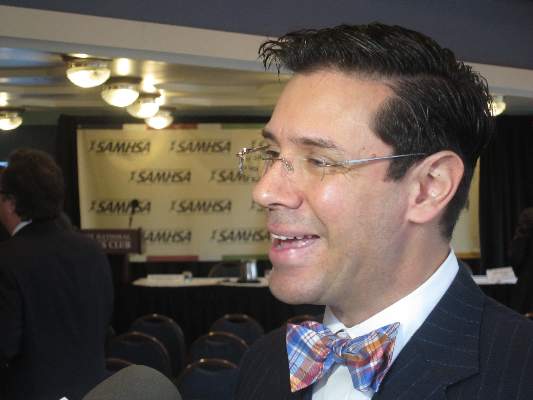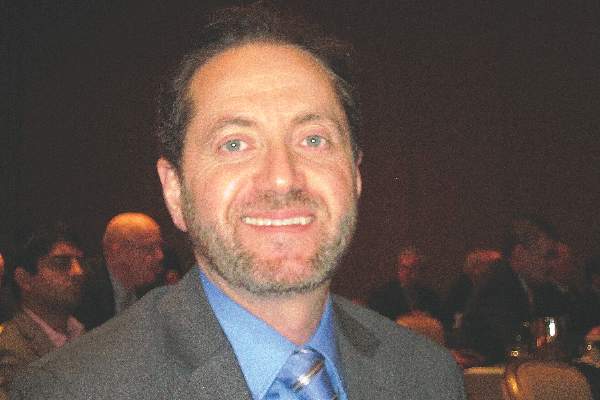User login
FDA green lights sublingual antipsychotic to treat bipolar I in children
For the first time in 5 years, the Food and Drug Administration has approved an application to market an antipsychotic to clinicians for treating bipolar I disorder in children aged 10-17 years.
Actavis, the Dublin-based pharmaceutical manufacturer, announced March 13 that the FDA has approved the company’s supplemental new drug application for asenapine (Saphris), a second-generation atypical antipsychotic, as monotherapy for the acute treatment of manic or mixed episodes associated with bipolar I disorder in this pediatric population.
The FDA approved asenapine in 2009 for treating adults with manic or mixed episodes of bipolar I, either as monotherapy or adjunctive to either lithium or valproate. It also is indicated for the acute or maintenance treatment of schizophrenia in adults.
Asenapine is administered as a sublingual tablet, and the company announced in the statement that it would begin marketing black cherry–flavored sublingual asenapine tablets in 2.5 mg, 5 mg, and 10 mg doses beginning in the second quarter of this year.
According to the manufacturer, the agency’s approval was granted based on the results of a 3-week monotherapy trial in 403 pediatric patients, aged 10-17 years, 302 of whom were treated twice daily with either 2.5 mg, 5 mg, or 10 mg of asenapine. The drug maker also said asenapine demonstrated improvement in the Young Mania Rating Scale total score and the Clinical Global Impressions-Bipolar Scale overall score, compared with placebo.
When asked about the approval, Dr. David Fassler said it's helpful to have a range of medications to treat pediatric patients with bipolar disorder. "However, the current approval is based on results of a relatively short-term clinical trial," said Dr. Fassler, clinical professor of psychiatry at the University of Vermont, Burlington. "In the real world, many young people ultimately take atypical antipsychotics for an extended period of time. Physicians and parents need data on the safety and efficacy of these medications when used on a more long-term or ongoing basis in order to make fully informed decisions about treatment options."
The most common side effects the company said it recorded in the pediatric clinical trial were sleepiness, dizziness, strange sense of taste, numbing of the mouth, nausea, increased appetite, feeling tired, and weight gain.
On Twitter @whitneymcknight
For the first time in 5 years, the Food and Drug Administration has approved an application to market an antipsychotic to clinicians for treating bipolar I disorder in children aged 10-17 years.
Actavis, the Dublin-based pharmaceutical manufacturer, announced March 13 that the FDA has approved the company’s supplemental new drug application for asenapine (Saphris), a second-generation atypical antipsychotic, as monotherapy for the acute treatment of manic or mixed episodes associated with bipolar I disorder in this pediatric population.
The FDA approved asenapine in 2009 for treating adults with manic or mixed episodes of bipolar I, either as monotherapy or adjunctive to either lithium or valproate. It also is indicated for the acute or maintenance treatment of schizophrenia in adults.
Asenapine is administered as a sublingual tablet, and the company announced in the statement that it would begin marketing black cherry–flavored sublingual asenapine tablets in 2.5 mg, 5 mg, and 10 mg doses beginning in the second quarter of this year.
According to the manufacturer, the agency’s approval was granted based on the results of a 3-week monotherapy trial in 403 pediatric patients, aged 10-17 years, 302 of whom were treated twice daily with either 2.5 mg, 5 mg, or 10 mg of asenapine. The drug maker also said asenapine demonstrated improvement in the Young Mania Rating Scale total score and the Clinical Global Impressions-Bipolar Scale overall score, compared with placebo.
When asked about the approval, Dr. David Fassler said it's helpful to have a range of medications to treat pediatric patients with bipolar disorder. "However, the current approval is based on results of a relatively short-term clinical trial," said Dr. Fassler, clinical professor of psychiatry at the University of Vermont, Burlington. "In the real world, many young people ultimately take atypical antipsychotics for an extended period of time. Physicians and parents need data on the safety and efficacy of these medications when used on a more long-term or ongoing basis in order to make fully informed decisions about treatment options."
The most common side effects the company said it recorded in the pediatric clinical trial were sleepiness, dizziness, strange sense of taste, numbing of the mouth, nausea, increased appetite, feeling tired, and weight gain.
On Twitter @whitneymcknight
For the first time in 5 years, the Food and Drug Administration has approved an application to market an antipsychotic to clinicians for treating bipolar I disorder in children aged 10-17 years.
Actavis, the Dublin-based pharmaceutical manufacturer, announced March 13 that the FDA has approved the company’s supplemental new drug application for asenapine (Saphris), a second-generation atypical antipsychotic, as monotherapy for the acute treatment of manic or mixed episodes associated with bipolar I disorder in this pediatric population.
The FDA approved asenapine in 2009 for treating adults with manic or mixed episodes of bipolar I, either as monotherapy or adjunctive to either lithium or valproate. It also is indicated for the acute or maintenance treatment of schizophrenia in adults.
Asenapine is administered as a sublingual tablet, and the company announced in the statement that it would begin marketing black cherry–flavored sublingual asenapine tablets in 2.5 mg, 5 mg, and 10 mg doses beginning in the second quarter of this year.
According to the manufacturer, the agency’s approval was granted based on the results of a 3-week monotherapy trial in 403 pediatric patients, aged 10-17 years, 302 of whom were treated twice daily with either 2.5 mg, 5 mg, or 10 mg of asenapine. The drug maker also said asenapine demonstrated improvement in the Young Mania Rating Scale total score and the Clinical Global Impressions-Bipolar Scale overall score, compared with placebo.
When asked about the approval, Dr. David Fassler said it's helpful to have a range of medications to treat pediatric patients with bipolar disorder. "However, the current approval is based on results of a relatively short-term clinical trial," said Dr. Fassler, clinical professor of psychiatry at the University of Vermont, Burlington. "In the real world, many young people ultimately take atypical antipsychotics for an extended period of time. Physicians and parents need data on the safety and efficacy of these medications when used on a more long-term or ongoing basis in order to make fully informed decisions about treatment options."
The most common side effects the company said it recorded in the pediatric clinical trial were sleepiness, dizziness, strange sense of taste, numbing of the mouth, nausea, increased appetite, feeling tired, and weight gain.
On Twitter @whitneymcknight
Acute renal failure biggest short-term risk in I-EVAR explantation
SCOTTSDALE, ARIZ. – Acute renal failure occurred postoperatively in one-third of patients who underwent endograft explantation after endovascular abdominal aortic aneurysm repair (EVAR), according to the results of a small retrospective study.
The perioperative infected EVAR (I-EVAR) mortality across the study’s 36 patient records (83% male patients, average age 69 years), culled from four surgery centers’ data from 1997 to 2014, was 8%. The overall mortality was 25%, according to Dr. Victor J. Davila of Mayo Clinic Arizona, Phoenix, and his colleagues. Dr. Davila presented the findings at the Southern Association for Vascular Surgery annual meeting.
“These data show that I-EVAR explantation can be performed safely, with acceptable morbidity and mortality,” said Dr. Davila, who noted that while acceptable, the rates were still high, particularly for acute renal failure.
“We did not find any difference between the patients who developed renal failure and the type of graft, whether or not there was suprarenal fixation, and an incidence of postoperative acute renal failure,” Dr. Davila said, “However, because acute renal failure is multifactorial, we need to minimize aortic clamp time, as well as minimize the aortic intimal disruption around the renal arteries.”
Three deaths occurred within 30 days post operation, all from anastomotic dehiscence. Additional short-term morbidities included respiratory failure that required tracheostomy in three patients, and bleeding and sepsis in two patients each. Six patients required re-exploration because of infected hematoma, lymphatic leak, small-bowel perforation, open abdomen at initial operation, and anastomotic bleeding. Six more deaths occurred at a mean follow-up of 402 days. One death was attributable to a ruptured aneurysm, another to a progressive inflammatory illness, and four deaths were of indeterminate cause.
Only three of the explantations reviewed by Dr. Davila and his colleagues were considered emergent. The rest (92%) were either elective or urgent. Infected patients tended to present with leukocytosis (63%), pain (58%), and fever (56%), usually about 65 days prior to explantation. The average time between EVAR and presentation with infection was 589 days.
Although most underwent total graft excision, two patients underwent partial excision, including one with a distal iliac limb infection that showed no sign of infection within the main portion of the endograft. Nearly three-quarters of patients had in situ reconstruction.
While nearly a third of patients had positive preoperative blood cultures indicating infection, 81% of intraoperative cultures taken from the explanted graft, aneurysm wall, or sac contents indicated infection.
The gram-positive Staphylococcus and Streptococcus were the most common organisms found in cultures (33% and 17%, respectively), although anaerobics were found in a third of patients, gram negatives in a quarter of patients, and fungal infections in 14%. A majority (58%) of patients received long-term suppressive antibiotic therapy.
Surgeons should reserve the option to keep a graft in situ only in infected EVAR patients who likely would not survive surgical explantation and reconstruction, Dr. Davila said. “Although I believe [medical management] is an alternative, the best course of action is to remove the endograft.”
On Twitter @whitneymcknight
SCOTTSDALE, ARIZ. – Acute renal failure occurred postoperatively in one-third of patients who underwent endograft explantation after endovascular abdominal aortic aneurysm repair (EVAR), according to the results of a small retrospective study.
The perioperative infected EVAR (I-EVAR) mortality across the study’s 36 patient records (83% male patients, average age 69 years), culled from four surgery centers’ data from 1997 to 2014, was 8%. The overall mortality was 25%, according to Dr. Victor J. Davila of Mayo Clinic Arizona, Phoenix, and his colleagues. Dr. Davila presented the findings at the Southern Association for Vascular Surgery annual meeting.
“These data show that I-EVAR explantation can be performed safely, with acceptable morbidity and mortality,” said Dr. Davila, who noted that while acceptable, the rates were still high, particularly for acute renal failure.
“We did not find any difference between the patients who developed renal failure and the type of graft, whether or not there was suprarenal fixation, and an incidence of postoperative acute renal failure,” Dr. Davila said, “However, because acute renal failure is multifactorial, we need to minimize aortic clamp time, as well as minimize the aortic intimal disruption around the renal arteries.”
Three deaths occurred within 30 days post operation, all from anastomotic dehiscence. Additional short-term morbidities included respiratory failure that required tracheostomy in three patients, and bleeding and sepsis in two patients each. Six patients required re-exploration because of infected hematoma, lymphatic leak, small-bowel perforation, open abdomen at initial operation, and anastomotic bleeding. Six more deaths occurred at a mean follow-up of 402 days. One death was attributable to a ruptured aneurysm, another to a progressive inflammatory illness, and four deaths were of indeterminate cause.
Only three of the explantations reviewed by Dr. Davila and his colleagues were considered emergent. The rest (92%) were either elective or urgent. Infected patients tended to present with leukocytosis (63%), pain (58%), and fever (56%), usually about 65 days prior to explantation. The average time between EVAR and presentation with infection was 589 days.
Although most underwent total graft excision, two patients underwent partial excision, including one with a distal iliac limb infection that showed no sign of infection within the main portion of the endograft. Nearly three-quarters of patients had in situ reconstruction.
While nearly a third of patients had positive preoperative blood cultures indicating infection, 81% of intraoperative cultures taken from the explanted graft, aneurysm wall, or sac contents indicated infection.
The gram-positive Staphylococcus and Streptococcus were the most common organisms found in cultures (33% and 17%, respectively), although anaerobics were found in a third of patients, gram negatives in a quarter of patients, and fungal infections in 14%. A majority (58%) of patients received long-term suppressive antibiotic therapy.
Surgeons should reserve the option to keep a graft in situ only in infected EVAR patients who likely would not survive surgical explantation and reconstruction, Dr. Davila said. “Although I believe [medical management] is an alternative, the best course of action is to remove the endograft.”
On Twitter @whitneymcknight
SCOTTSDALE, ARIZ. – Acute renal failure occurred postoperatively in one-third of patients who underwent endograft explantation after endovascular abdominal aortic aneurysm repair (EVAR), according to the results of a small retrospective study.
The perioperative infected EVAR (I-EVAR) mortality across the study’s 36 patient records (83% male patients, average age 69 years), culled from four surgery centers’ data from 1997 to 2014, was 8%. The overall mortality was 25%, according to Dr. Victor J. Davila of Mayo Clinic Arizona, Phoenix, and his colleagues. Dr. Davila presented the findings at the Southern Association for Vascular Surgery annual meeting.
“These data show that I-EVAR explantation can be performed safely, with acceptable morbidity and mortality,” said Dr. Davila, who noted that while acceptable, the rates were still high, particularly for acute renal failure.
“We did not find any difference between the patients who developed renal failure and the type of graft, whether or not there was suprarenal fixation, and an incidence of postoperative acute renal failure,” Dr. Davila said, “However, because acute renal failure is multifactorial, we need to minimize aortic clamp time, as well as minimize the aortic intimal disruption around the renal arteries.”
Three deaths occurred within 30 days post operation, all from anastomotic dehiscence. Additional short-term morbidities included respiratory failure that required tracheostomy in three patients, and bleeding and sepsis in two patients each. Six patients required re-exploration because of infected hematoma, lymphatic leak, small-bowel perforation, open abdomen at initial operation, and anastomotic bleeding. Six more deaths occurred at a mean follow-up of 402 days. One death was attributable to a ruptured aneurysm, another to a progressive inflammatory illness, and four deaths were of indeterminate cause.
Only three of the explantations reviewed by Dr. Davila and his colleagues were considered emergent. The rest (92%) were either elective or urgent. Infected patients tended to present with leukocytosis (63%), pain (58%), and fever (56%), usually about 65 days prior to explantation. The average time between EVAR and presentation with infection was 589 days.
Although most underwent total graft excision, two patients underwent partial excision, including one with a distal iliac limb infection that showed no sign of infection within the main portion of the endograft. Nearly three-quarters of patients had in situ reconstruction.
While nearly a third of patients had positive preoperative blood cultures indicating infection, 81% of intraoperative cultures taken from the explanted graft, aneurysm wall, or sac contents indicated infection.
The gram-positive Staphylococcus and Streptococcus were the most common organisms found in cultures (33% and 17%, respectively), although anaerobics were found in a third of patients, gram negatives in a quarter of patients, and fungal infections in 14%. A majority (58%) of patients received long-term suppressive antibiotic therapy.
Surgeons should reserve the option to keep a graft in situ only in infected EVAR patients who likely would not survive surgical explantation and reconstruction, Dr. Davila said. “Although I believe [medical management] is an alternative, the best course of action is to remove the endograft.”
On Twitter @whitneymcknight
AT THE SAVS ANNUAL MEETING
Key clinical point: Minimizing cross-clamp time may reduce the rate of acute renal failure 30 days post op in infected EVAR explantation patients.
Major finding: One-third of I-EVAR patients had postoperative acute renal failure; perioperative mortality in I-EVAR was 8%, and overall mortality was 25%.
Data source: Retrospective analysis of 36 patients with infected EVAR explants performed between 1997 and 2014 across four surgical centers.
Disclosures: Dr. Davila reported he had no relevant disclosures.
VIDEO: When to use glycopyrrolate as first-line hyperhidrosis therapy
KAUAI, HAWAII – When should glycopyrrolate be used as first-line therapy in the treatment of hyperhidrosis? And if it’s not the first treatment, what should take its place?
In a video report from the 2015 Hawaii Dermatology Seminar sponsored by Global Academy for Medical Education/Skin Disease Education Foundation, Dr. Christopher Zachary and Dr. Joshua Spanogle share their thoughts on the latest in hyperhidrosis treatment.
Dr. Zachary disclosed that he has financial relationships with Cutera and Solta. Dr. Spanogle disclosed he has relationships with Illumina and Quantified Skin. SDEF and this news organization are owned by the same parent company.
The video associated with this article is no longer available on this site. Please view all of our videos on the MDedge YouTube channel
On Twitter @whitneymcknight
KAUAI, HAWAII – When should glycopyrrolate be used as first-line therapy in the treatment of hyperhidrosis? And if it’s not the first treatment, what should take its place?
In a video report from the 2015 Hawaii Dermatology Seminar sponsored by Global Academy for Medical Education/Skin Disease Education Foundation, Dr. Christopher Zachary and Dr. Joshua Spanogle share their thoughts on the latest in hyperhidrosis treatment.
Dr. Zachary disclosed that he has financial relationships with Cutera and Solta. Dr. Spanogle disclosed he has relationships with Illumina and Quantified Skin. SDEF and this news organization are owned by the same parent company.
The video associated with this article is no longer available on this site. Please view all of our videos on the MDedge YouTube channel
On Twitter @whitneymcknight
KAUAI, HAWAII – When should glycopyrrolate be used as first-line therapy in the treatment of hyperhidrosis? And if it’s not the first treatment, what should take its place?
In a video report from the 2015 Hawaii Dermatology Seminar sponsored by Global Academy for Medical Education/Skin Disease Education Foundation, Dr. Christopher Zachary and Dr. Joshua Spanogle share their thoughts on the latest in hyperhidrosis treatment.
Dr. Zachary disclosed that he has financial relationships with Cutera and Solta. Dr. Spanogle disclosed he has relationships with Illumina and Quantified Skin. SDEF and this news organization are owned by the same parent company.
The video associated with this article is no longer available on this site. Please view all of our videos on the MDedge YouTube channel
On Twitter @whitneymcknight
AT SDEF HAWAII DERMATOLOGY SEMINAR 2015
Suicide prevention app for primary care providers expected to improve suicide screening
WASHINGTON – Primary care providers are being urged by a federal agency to heighten their sensitivities to patients at risk for suicide.
Citing data that nearly half of all persons who died by suicide had seen a primary care provider within the month prior to their death, Pamela S. Hyde, J.D., administrator of the Substance Abuse and Mental Health Services Administration, overseen by the U.S. Department of Health & Human Services, today announced the launch of the Suicide Safe app, a free risk-assessment tool for providers to screen patients at risk for suicide.
According to Ms. Hyde, who spoke during a SAMHSA news briefing, suicide is the leading cause of death in the United States among those aged 15-29 years, with one person dying of suicide every 13 minutes. Ms. Hyde also noted that suicide was seen to trend upward between the years 1999 and 2010 when the age-adjusted suicide rate for people aged 35-64 years increased 28%.
“Our offices are the key access points where we can start to identify these patients,” said Dr. Fabian Sandoval, a Washington-based researcher and clinical protocols consultant who spoke at the news briefing. “But we are not the experts, we are not the psychiatrists, so what are we going to do?”
Dr. Sandoval said the tool would support the generations of primary care providers, including advance practice nurses and physician assistants, who did not receive any formal mental or behavioral health care training, which he said was most of the “old guard” in medicine.
Based on the SAFE-T (Suicide Assessment Five-Step Evaluation and Triage) protocols developed by Dr. Douglas Jacobs of the department of psychiatry at Harvard Medical School, Boston, and the chair of the American Psychiatric Association Practice Guidelines on Suicide, the app helps identify at-risk patients and find local facilities where patients can be referred for emergent or other treatment.
“If I am a primary care provider who doesn’t feel adequately prepared to deal with a patient in the middle of a suicidal crisis, I can use the treatment locator to find a specialized behavioral health provider within a certain radius and immediately link to that person right off the app and get that patient in for an appointment or an emergency visit,” Robert Carrol, an advanced practice registered nurse and a member of the app’s research and development team, said in an interview.
“It’s a tool that can bridge that gap of fear that often prevents providers from even opening the conversation. That’s always the first challenge, providers not wanting to ‘go there’ because they don’t want to answer a question that they won’t know how to answer or respond to.”
Starting the conversation in an open-ended way is crucial to getting a patient to speak honestly about his or her condition, Dr. Mitra Ahadpour, a primary care physician from Germantown, Md., and a clinical communications consultant with SAMHSA, said in an interview. “The open-ended question prompts in the app are very important. We have research that shows closed-ended questions turn the patient off, questions such as ‘You’re not thinking of killing yourself, are you?’ Instead, keep it very simple. Ask, ‘How are you doing today? Then take a second to see what they say.”
Even if primary care physicians are willing to ask and respond to their patients in acute danger of suicide, there is still the need to ensure that even if patients are referred to the appropriate facility, that there is enough room to accommodate them, according to Dr. Sandoval. “We’ll be able to identify more patients who are in suicidal situations than before, but now what? What do we do with this patient? That is a question we have to [address] as well.”
Incorporating the app into clinical practice should not be difficult and could even help encourage a physician to treat the patient him- or herself if the risk for suicide is found to be low, according to Dr. Ahadpour. “There are many points in the system where the app can be integrated. The PHQ-9 (patient health questionnaire that screens for depression) is included in the app, and you can have your patients fill that out ahead of time,” Dr. Ahadpour, who was not on the news briefing panel, said in an interview. “That way the clinician will already know if there is a need to take things to the second step or [assess] for a suicidal risk. If the provider feels comfortable that there is no risk for suicide, then they can treat the patient for depression, for example.” If they do not feel comfortable treating the patient, then “at least they have assessed the patient,” she added. Validated evaluation tools for other mental health conditions, including one for general anxiety disorder are also included in the app, Dr. Ahadpour said. Depression and anxiety are two major risk factors for suicidal ideation.
When asked by a reporter about how primary care physicians should bill their time for using the app, Mr. Carroll said the app included IDC-9 and ICD-10 codes.
For more information about the app, visit SAMHSA’s website.
Dr. Jacobs said the app is freely available at any smart phone app store.
On Twitter @whitneymcknight
WASHINGTON – Primary care providers are being urged by a federal agency to heighten their sensitivities to patients at risk for suicide.
Citing data that nearly half of all persons who died by suicide had seen a primary care provider within the month prior to their death, Pamela S. Hyde, J.D., administrator of the Substance Abuse and Mental Health Services Administration, overseen by the U.S. Department of Health & Human Services, today announced the launch of the Suicide Safe app, a free risk-assessment tool for providers to screen patients at risk for suicide.
According to Ms. Hyde, who spoke during a SAMHSA news briefing, suicide is the leading cause of death in the United States among those aged 15-29 years, with one person dying of suicide every 13 minutes. Ms. Hyde also noted that suicide was seen to trend upward between the years 1999 and 2010 when the age-adjusted suicide rate for people aged 35-64 years increased 28%.
“Our offices are the key access points where we can start to identify these patients,” said Dr. Fabian Sandoval, a Washington-based researcher and clinical protocols consultant who spoke at the news briefing. “But we are not the experts, we are not the psychiatrists, so what are we going to do?”
Dr. Sandoval said the tool would support the generations of primary care providers, including advance practice nurses and physician assistants, who did not receive any formal mental or behavioral health care training, which he said was most of the “old guard” in medicine.
Based on the SAFE-T (Suicide Assessment Five-Step Evaluation and Triage) protocols developed by Dr. Douglas Jacobs of the department of psychiatry at Harvard Medical School, Boston, and the chair of the American Psychiatric Association Practice Guidelines on Suicide, the app helps identify at-risk patients and find local facilities where patients can be referred for emergent or other treatment.
“If I am a primary care provider who doesn’t feel adequately prepared to deal with a patient in the middle of a suicidal crisis, I can use the treatment locator to find a specialized behavioral health provider within a certain radius and immediately link to that person right off the app and get that patient in for an appointment or an emergency visit,” Robert Carrol, an advanced practice registered nurse and a member of the app’s research and development team, said in an interview.
“It’s a tool that can bridge that gap of fear that often prevents providers from even opening the conversation. That’s always the first challenge, providers not wanting to ‘go there’ because they don’t want to answer a question that they won’t know how to answer or respond to.”
Starting the conversation in an open-ended way is crucial to getting a patient to speak honestly about his or her condition, Dr. Mitra Ahadpour, a primary care physician from Germantown, Md., and a clinical communications consultant with SAMHSA, said in an interview. “The open-ended question prompts in the app are very important. We have research that shows closed-ended questions turn the patient off, questions such as ‘You’re not thinking of killing yourself, are you?’ Instead, keep it very simple. Ask, ‘How are you doing today? Then take a second to see what they say.”
Even if primary care physicians are willing to ask and respond to their patients in acute danger of suicide, there is still the need to ensure that even if patients are referred to the appropriate facility, that there is enough room to accommodate them, according to Dr. Sandoval. “We’ll be able to identify more patients who are in suicidal situations than before, but now what? What do we do with this patient? That is a question we have to [address] as well.”
Incorporating the app into clinical practice should not be difficult and could even help encourage a physician to treat the patient him- or herself if the risk for suicide is found to be low, according to Dr. Ahadpour. “There are many points in the system where the app can be integrated. The PHQ-9 (patient health questionnaire that screens for depression) is included in the app, and you can have your patients fill that out ahead of time,” Dr. Ahadpour, who was not on the news briefing panel, said in an interview. “That way the clinician will already know if there is a need to take things to the second step or [assess] for a suicidal risk. If the provider feels comfortable that there is no risk for suicide, then they can treat the patient for depression, for example.” If they do not feel comfortable treating the patient, then “at least they have assessed the patient,” she added. Validated evaluation tools for other mental health conditions, including one for general anxiety disorder are also included in the app, Dr. Ahadpour said. Depression and anxiety are two major risk factors for suicidal ideation.
When asked by a reporter about how primary care physicians should bill their time for using the app, Mr. Carroll said the app included IDC-9 and ICD-10 codes.
For more information about the app, visit SAMHSA’s website.
Dr. Jacobs said the app is freely available at any smart phone app store.
On Twitter @whitneymcknight
WASHINGTON – Primary care providers are being urged by a federal agency to heighten their sensitivities to patients at risk for suicide.
Citing data that nearly half of all persons who died by suicide had seen a primary care provider within the month prior to their death, Pamela S. Hyde, J.D., administrator of the Substance Abuse and Mental Health Services Administration, overseen by the U.S. Department of Health & Human Services, today announced the launch of the Suicide Safe app, a free risk-assessment tool for providers to screen patients at risk for suicide.
According to Ms. Hyde, who spoke during a SAMHSA news briefing, suicide is the leading cause of death in the United States among those aged 15-29 years, with one person dying of suicide every 13 minutes. Ms. Hyde also noted that suicide was seen to trend upward between the years 1999 and 2010 when the age-adjusted suicide rate for people aged 35-64 years increased 28%.
“Our offices are the key access points where we can start to identify these patients,” said Dr. Fabian Sandoval, a Washington-based researcher and clinical protocols consultant who spoke at the news briefing. “But we are not the experts, we are not the psychiatrists, so what are we going to do?”
Dr. Sandoval said the tool would support the generations of primary care providers, including advance practice nurses and physician assistants, who did not receive any formal mental or behavioral health care training, which he said was most of the “old guard” in medicine.
Based on the SAFE-T (Suicide Assessment Five-Step Evaluation and Triage) protocols developed by Dr. Douglas Jacobs of the department of psychiatry at Harvard Medical School, Boston, and the chair of the American Psychiatric Association Practice Guidelines on Suicide, the app helps identify at-risk patients and find local facilities where patients can be referred for emergent or other treatment.
“If I am a primary care provider who doesn’t feel adequately prepared to deal with a patient in the middle of a suicidal crisis, I can use the treatment locator to find a specialized behavioral health provider within a certain radius and immediately link to that person right off the app and get that patient in for an appointment or an emergency visit,” Robert Carrol, an advanced practice registered nurse and a member of the app’s research and development team, said in an interview.
“It’s a tool that can bridge that gap of fear that often prevents providers from even opening the conversation. That’s always the first challenge, providers not wanting to ‘go there’ because they don’t want to answer a question that they won’t know how to answer or respond to.”
Starting the conversation in an open-ended way is crucial to getting a patient to speak honestly about his or her condition, Dr. Mitra Ahadpour, a primary care physician from Germantown, Md., and a clinical communications consultant with SAMHSA, said in an interview. “The open-ended question prompts in the app are very important. We have research that shows closed-ended questions turn the patient off, questions such as ‘You’re not thinking of killing yourself, are you?’ Instead, keep it very simple. Ask, ‘How are you doing today? Then take a second to see what they say.”
Even if primary care physicians are willing to ask and respond to their patients in acute danger of suicide, there is still the need to ensure that even if patients are referred to the appropriate facility, that there is enough room to accommodate them, according to Dr. Sandoval. “We’ll be able to identify more patients who are in suicidal situations than before, but now what? What do we do with this patient? That is a question we have to [address] as well.”
Incorporating the app into clinical practice should not be difficult and could even help encourage a physician to treat the patient him- or herself if the risk for suicide is found to be low, according to Dr. Ahadpour. “There are many points in the system where the app can be integrated. The PHQ-9 (patient health questionnaire that screens for depression) is included in the app, and you can have your patients fill that out ahead of time,” Dr. Ahadpour, who was not on the news briefing panel, said in an interview. “That way the clinician will already know if there is a need to take things to the second step or [assess] for a suicidal risk. If the provider feels comfortable that there is no risk for suicide, then they can treat the patient for depression, for example.” If they do not feel comfortable treating the patient, then “at least they have assessed the patient,” she added. Validated evaluation tools for other mental health conditions, including one for general anxiety disorder are also included in the app, Dr. Ahadpour said. Depression and anxiety are two major risk factors for suicidal ideation.
When asked by a reporter about how primary care physicians should bill their time for using the app, Mr. Carroll said the app included IDC-9 and ICD-10 codes.
For more information about the app, visit SAMHSA’s website.
Dr. Jacobs said the app is freely available at any smart phone app store.
On Twitter @whitneymcknight
Biologics: Timing of use in IBD still variable
ORLANDO, FLA. – Biologics used to treat inflammatory bowel disease could be more effective if they were used earlier in patients with these conditions, according to an expert.
“The earlier the better in patients who need them,” said Dr. Stephen B. Hanauer, professor of medicine at Northwestern University (Chicago) and medical director of the school’s Digestive Health Center. “Biologics should be used with short-term combination therapies and with therapeutic drug monitoring.” Dr. Hanauer made his remarks at the most recent annual Advances in IBD meeting sponsored by the Crohn’s and Colitis Foundation of America.
Currently, most clinicians regard the use of immunomodulators in inflammatory bowel disease as a “last ditch effort” treatment, and turn to them only after patients fail first-line therapies. Similarly, guidelines in the field recommend immunomodulation for moderate to severe disease, the time when Dr. Hanauaer said “the disease has progressed to the point where there is already the structural damage we’re trying to prevent.”
Instead, he believes IBD sufferers would benefit from prospective trials that show earlier intervention yields higher remission rates, particularly in steroid-naive populations.
“We should learn from the rheumatoid arthritis people who figured out that administering highly effective agents earlier has the potential to modify long-term disease behavior,” Dr. Hanauer said.
Studies cited by Dr. Hanauer indicated that when biologics were introduced when patients were steroid- and immunosuppressive-naive, remission rates doubled, up to two-thirds of patients compared with only a third of patients who were given combination therapy. The results held as early as 26 weeks and at 1 year follow-up. “When we gave biologics on top of the other therapies, they offered no advantage.”
That the drugs are more widely used in rheumatoid conditions has also impacted dosing levels, said Dr. Hanauer, who said that much higher doses likely would yield better remission rates, particularly in Crohn’s disease. Not dosing at the correct levels, Dr. Harnauer said, can lead to serum troughs that diminish the patient’s response to treatment, and put them at risk of immunogenicity. “Trough levels can be used to predict clinical remission,” he said. “The problem is that we don’t have very good prospective data on it.”
Dr. Bruce E. Sands, chief of gastroenterology at Mount Sinai in (New York), and another presenter who spoke about biologics in IBD at the meeting, agreed. “When a patient fails the first anti-TNF, the question is whether it has been adequately dosed, particularly in the case of severe ulcerative colitis where we’re really starting to understand that we need higher doses to get the disease under control.”
As for earlier intervention in ulcerative colitis with biologics, Dr. Sands believed the timing is more fluid. “It really is your choice and the patient’s choice,” he said. The same was true for the recent addition of the biologic vedolizumab to the ulcerative colitis armementarium, he said, noting that there is a response both during induction and maintenance phases for all biologic therapies in ulcerative colitis.
Although infections and neoplasm are concerns with all biologic therapies, Dr. Harnauer downplayed the risks when compared to corticosteroid therapy, particularly in Crohn’s disease. “The risk of neoplasia in patients given anti-TNF (anti-tumor necrosis factor) therapy disappears after adjusting for the use of azathioprine,” he said.
Dr. Sands was less sanguine about the potential risks of anti-TNF treatment, reminding the audience that the drugs carry black box warnings from the U.S. Food and Drug Administration, and that patients must be screened for their candidacy before administering immunomodulation therapy. “It is possible to develop a variety of autoimmune disorders, and immunogenicity with these drugs,” said Dr. Sands, also adding that a risk of demylenating disorders must also be accounted for. “Make sure you monitor your patients, and that you explain the risks to them.”
Regardless of when biologics are used in treatment, both presenters agreed that their exorbitant cost is an issue. “We cannot use them for every patient who walks through the door,” said Dr. Sands.
For Dr. Harnauer, the cost stands in the way of the earlier positioning of the drugs in treatment algorithms. “If we were talking about a treatment that only cost a few dollars, we wouldn’t be worrying about any of this.” Prospective pharmaco-economic studies that go beyond measuring the in-patient and surgical costs, but account for the timing and use of biologics could help strengthen the case for earlier treatment, he said.
On Twitter @whitneymcknight
ORLANDO, FLA. – Biologics used to treat inflammatory bowel disease could be more effective if they were used earlier in patients with these conditions, according to an expert.
“The earlier the better in patients who need them,” said Dr. Stephen B. Hanauer, professor of medicine at Northwestern University (Chicago) and medical director of the school’s Digestive Health Center. “Biologics should be used with short-term combination therapies and with therapeutic drug monitoring.” Dr. Hanauer made his remarks at the most recent annual Advances in IBD meeting sponsored by the Crohn’s and Colitis Foundation of America.
Currently, most clinicians regard the use of immunomodulators in inflammatory bowel disease as a “last ditch effort” treatment, and turn to them only after patients fail first-line therapies. Similarly, guidelines in the field recommend immunomodulation for moderate to severe disease, the time when Dr. Hanauaer said “the disease has progressed to the point where there is already the structural damage we’re trying to prevent.”
Instead, he believes IBD sufferers would benefit from prospective trials that show earlier intervention yields higher remission rates, particularly in steroid-naive populations.
“We should learn from the rheumatoid arthritis people who figured out that administering highly effective agents earlier has the potential to modify long-term disease behavior,” Dr. Hanauer said.
Studies cited by Dr. Hanauer indicated that when biologics were introduced when patients were steroid- and immunosuppressive-naive, remission rates doubled, up to two-thirds of patients compared with only a third of patients who were given combination therapy. The results held as early as 26 weeks and at 1 year follow-up. “When we gave biologics on top of the other therapies, they offered no advantage.”
That the drugs are more widely used in rheumatoid conditions has also impacted dosing levels, said Dr. Hanauer, who said that much higher doses likely would yield better remission rates, particularly in Crohn’s disease. Not dosing at the correct levels, Dr. Harnauer said, can lead to serum troughs that diminish the patient’s response to treatment, and put them at risk of immunogenicity. “Trough levels can be used to predict clinical remission,” he said. “The problem is that we don’t have very good prospective data on it.”
Dr. Bruce E. Sands, chief of gastroenterology at Mount Sinai in (New York), and another presenter who spoke about biologics in IBD at the meeting, agreed. “When a patient fails the first anti-TNF, the question is whether it has been adequately dosed, particularly in the case of severe ulcerative colitis where we’re really starting to understand that we need higher doses to get the disease under control.”
As for earlier intervention in ulcerative colitis with biologics, Dr. Sands believed the timing is more fluid. “It really is your choice and the patient’s choice,” he said. The same was true for the recent addition of the biologic vedolizumab to the ulcerative colitis armementarium, he said, noting that there is a response both during induction and maintenance phases for all biologic therapies in ulcerative colitis.
Although infections and neoplasm are concerns with all biologic therapies, Dr. Harnauer downplayed the risks when compared to corticosteroid therapy, particularly in Crohn’s disease. “The risk of neoplasia in patients given anti-TNF (anti-tumor necrosis factor) therapy disappears after adjusting for the use of azathioprine,” he said.
Dr. Sands was less sanguine about the potential risks of anti-TNF treatment, reminding the audience that the drugs carry black box warnings from the U.S. Food and Drug Administration, and that patients must be screened for their candidacy before administering immunomodulation therapy. “It is possible to develop a variety of autoimmune disorders, and immunogenicity with these drugs,” said Dr. Sands, also adding that a risk of demylenating disorders must also be accounted for. “Make sure you monitor your patients, and that you explain the risks to them.”
Regardless of when biologics are used in treatment, both presenters agreed that their exorbitant cost is an issue. “We cannot use them for every patient who walks through the door,” said Dr. Sands.
For Dr. Harnauer, the cost stands in the way of the earlier positioning of the drugs in treatment algorithms. “If we were talking about a treatment that only cost a few dollars, we wouldn’t be worrying about any of this.” Prospective pharmaco-economic studies that go beyond measuring the in-patient and surgical costs, but account for the timing and use of biologics could help strengthen the case for earlier treatment, he said.
On Twitter @whitneymcknight
ORLANDO, FLA. – Biologics used to treat inflammatory bowel disease could be more effective if they were used earlier in patients with these conditions, according to an expert.
“The earlier the better in patients who need them,” said Dr. Stephen B. Hanauer, professor of medicine at Northwestern University (Chicago) and medical director of the school’s Digestive Health Center. “Biologics should be used with short-term combination therapies and with therapeutic drug monitoring.” Dr. Hanauer made his remarks at the most recent annual Advances in IBD meeting sponsored by the Crohn’s and Colitis Foundation of America.
Currently, most clinicians regard the use of immunomodulators in inflammatory bowel disease as a “last ditch effort” treatment, and turn to them only after patients fail first-line therapies. Similarly, guidelines in the field recommend immunomodulation for moderate to severe disease, the time when Dr. Hanauaer said “the disease has progressed to the point where there is already the structural damage we’re trying to prevent.”
Instead, he believes IBD sufferers would benefit from prospective trials that show earlier intervention yields higher remission rates, particularly in steroid-naive populations.
“We should learn from the rheumatoid arthritis people who figured out that administering highly effective agents earlier has the potential to modify long-term disease behavior,” Dr. Hanauer said.
Studies cited by Dr. Hanauer indicated that when biologics were introduced when patients were steroid- and immunosuppressive-naive, remission rates doubled, up to two-thirds of patients compared with only a third of patients who were given combination therapy. The results held as early as 26 weeks and at 1 year follow-up. “When we gave biologics on top of the other therapies, they offered no advantage.”
That the drugs are more widely used in rheumatoid conditions has also impacted dosing levels, said Dr. Hanauer, who said that much higher doses likely would yield better remission rates, particularly in Crohn’s disease. Not dosing at the correct levels, Dr. Harnauer said, can lead to serum troughs that diminish the patient’s response to treatment, and put them at risk of immunogenicity. “Trough levels can be used to predict clinical remission,” he said. “The problem is that we don’t have very good prospective data on it.”
Dr. Bruce E. Sands, chief of gastroenterology at Mount Sinai in (New York), and another presenter who spoke about biologics in IBD at the meeting, agreed. “When a patient fails the first anti-TNF, the question is whether it has been adequately dosed, particularly in the case of severe ulcerative colitis where we’re really starting to understand that we need higher doses to get the disease under control.”
As for earlier intervention in ulcerative colitis with biologics, Dr. Sands believed the timing is more fluid. “It really is your choice and the patient’s choice,” he said. The same was true for the recent addition of the biologic vedolizumab to the ulcerative colitis armementarium, he said, noting that there is a response both during induction and maintenance phases for all biologic therapies in ulcerative colitis.
Although infections and neoplasm are concerns with all biologic therapies, Dr. Harnauer downplayed the risks when compared to corticosteroid therapy, particularly in Crohn’s disease. “The risk of neoplasia in patients given anti-TNF (anti-tumor necrosis factor) therapy disappears after adjusting for the use of azathioprine,” he said.
Dr. Sands was less sanguine about the potential risks of anti-TNF treatment, reminding the audience that the drugs carry black box warnings from the U.S. Food and Drug Administration, and that patients must be screened for their candidacy before administering immunomodulation therapy. “It is possible to develop a variety of autoimmune disorders, and immunogenicity with these drugs,” said Dr. Sands, also adding that a risk of demylenating disorders must also be accounted for. “Make sure you monitor your patients, and that you explain the risks to them.”
Regardless of when biologics are used in treatment, both presenters agreed that their exorbitant cost is an issue. “We cannot use them for every patient who walks through the door,” said Dr. Sands.
For Dr. Harnauer, the cost stands in the way of the earlier positioning of the drugs in treatment algorithms. “If we were talking about a treatment that only cost a few dollars, we wouldn’t be worrying about any of this.” Prospective pharmaco-economic studies that go beyond measuring the in-patient and surgical costs, but account for the timing and use of biologics could help strengthen the case for earlier treatment, he said.
On Twitter @whitneymcknight
EXPERT ANALYSIS FROM CCFA/IBD
VIDEO: Expert tips to avoid eye ptosis
KAUAI, HAWAII– Ptosis can occur if toxins injected around the eyes are imprecisely placed, according to Dr. Brooke Sikora.
In this video report from the Hawaii Dermatology Seminar sponsored by Global Academy for Medical Education/Skin Disease Education Foundation, Dr. Sikora, a private practice dermatologist in Boston discusses how to avoid adverse events when injecting toxins around the lids and brows, and what to do should the procedure not go according to plan.
Dr. Sikora had no relevant financial conflicts to disclose.
SDEF and this news organ
On Twitter @whitneymcknight
KAUAI, HAWAII– Ptosis can occur if toxins injected around the eyes are imprecisely placed, according to Dr. Brooke Sikora.
In this video report from the Hawaii Dermatology Seminar sponsored by Global Academy for Medical Education/Skin Disease Education Foundation, Dr. Sikora, a private practice dermatologist in Boston discusses how to avoid adverse events when injecting toxins around the lids and brows, and what to do should the procedure not go according to plan.
Dr. Sikora had no relevant financial conflicts to disclose.
SDEF and this news organ
On Twitter @whitneymcknight
KAUAI, HAWAII– Ptosis can occur if toxins injected around the eyes are imprecisely placed, according to Dr. Brooke Sikora.
In this video report from the Hawaii Dermatology Seminar sponsored by Global Academy for Medical Education/Skin Disease Education Foundation, Dr. Sikora, a private practice dermatologist in Boston discusses how to avoid adverse events when injecting toxins around the lids and brows, and what to do should the procedure not go according to plan.
Dr. Sikora had no relevant financial conflicts to disclose.
SDEF and this news organ
On Twitter @whitneymcknight
AT SDEF HAWAII DERMATOLOGY SEMINAR
VIDEO: Best practices for antibiotic use in acne
KAUAI, HAWAII – Should you taper or stop your acne patient’s oral antibiotic abruptly? And what are the best topical and oral antibiotics to treat chronic acne? Dr. Linda Stein Gold of the Henry Ford Hospital in Detroit addresses these concerns and discusses the latest developments in topical antibiotics at the Hawaii Dermatology Seminar sponsored by Global Academy for Medical Education/Skin Disease Education Foundation. Dr. Gold disclosed she has several industry ties, including with Galderma, Roche, and Stiefel. SDEF and this news organization are owed by the same parent company.
On Twitter @whitneymcknight
KAUAI, HAWAII – Should you taper or stop your acne patient’s oral antibiotic abruptly? And what are the best topical and oral antibiotics to treat chronic acne? Dr. Linda Stein Gold of the Henry Ford Hospital in Detroit addresses these concerns and discusses the latest developments in topical antibiotics at the Hawaii Dermatology Seminar sponsored by Global Academy for Medical Education/Skin Disease Education Foundation. Dr. Gold disclosed she has several industry ties, including with Galderma, Roche, and Stiefel. SDEF and this news organization are owed by the same parent company.
On Twitter @whitneymcknight
KAUAI, HAWAII – Should you taper or stop your acne patient’s oral antibiotic abruptly? And what are the best topical and oral antibiotics to treat chronic acne? Dr. Linda Stein Gold of the Henry Ford Hospital in Detroit addresses these concerns and discusses the latest developments in topical antibiotics at the Hawaii Dermatology Seminar sponsored by Global Academy for Medical Education/Skin Disease Education Foundation. Dr. Gold disclosed she has several industry ties, including with Galderma, Roche, and Stiefel. SDEF and this news organization are owed by the same parent company.
On Twitter @whitneymcknight
AT SDEF HAWAII DERMATOLOGY SEMINAR
Clinical follow-up data promising for EVAR in AAA with angulated aortic neck
SCOTTSDALE, ARIZ. – Endovascular abdominal aortic aneurysm repair using a flexible endovascular stent graft in patients with infrarenal aortic neck angles of sixty degrees or greater had more favorable survival and major adverse event rates when compared with open repair, although the difference was not statistically significant, according to clinical, 2-year, postmarketing data.
At this year’s annual Southern Association for Vascular Surgery meeting, Dr. Mahmoud B. Malas presented 2-year safety and efficacy follow-up data from the PYTHAGORAS trial to evaluate the Aorfix (Lombard Medical, U.K.). The device, approved in 2013 by the Food and Drug Administration, is an endovascular stent graft for use in patients whose aortic neck angulation of between 60 and 90 degrees typically has disqualified them from having endovascular aneurysm repair (EVAR) for AAA.
The device is placed within the aneurysm, where it conforms to the individual patient’s anatomy, creating an internal bypass of the aneurysm to reduce the risk of rupture.
“The freedom from major adverse events, despite this hostile neck anatomy, was excellent,” Dr. Malas said of the data.
The PYTHAGORAS study enrolled and treated 151 patients with aortic neck angles of 60 degrees or greater, and 67 patients with necks less than 60 degrees using EVAR. The primary control group consisted of 67 patients undergoing actual open surgical repair (OSR). A secondary control group was a meta-analysis of 323 patients taken from other U.S. EVAR studies (SVS Lifeline).
There were no statistically significant differences between major adverse event rates, nor 30-day and 1-year mortality rates between low- or high-angle EVAR groups when compared with controls. There also was no difference between low- and high-angle EVAR patients sac shrinkage, type I/III endoleaks, and endograft migration, according to Dr. Malas.
The median neck angle in the EVAR group was 71 degrees (standard deviation of ±23 degrees; P < .05), compared with 48 degrees (SD, ± 23 degrees; P < .05) in the OSR control group. There were twice as many women in the EVAR group (35% vs.17%; P < .0001). Patient demographics and comorbidities were similar between the entire EVAR cohort and control group, with the exception of age (76 years vs. 70 years, respectively; P < .05) and heart failure (13% vs. 7%, P = .015). Operative data favored EVAR for procedure duration, blood loss, and hospital length of stay (P < .05 for all).
Dr. Malas said that in the combined EVAR cohort, there was a tendency for the infrarenal area to dilate more rapidly than the suprarenal aorta. “If the neck dilated more than 10%, there was a significant increase in risk of migration and sac expansion, especially close to the renal, but it was not true as you went beyond 7 mm distal to the renal.”
He also noted that the suprarenal aorta does change in association with migration and that there is a “clear association between the degree of oversizing and neck dilation.”
The presentation’s discussant, Dr. Jean M. Panneton, a vascular surgeon at Sentara Heart Hospital in Norfolk, Va., challenged the findings.
“Unfortunately, this trial did suffer from a slow accrual. As a result, only a small proportion of patients have reached the 5-year follow-up, and any subanalysis of such a small study population divided into three groups reduces the n value to the point that a type II error can easily be introduced into your analysis.”
Among the issues he raised was that the mortality data at 30 days, 1 year, and 2 years for the patients with the highest neck angulations could be misleading. “The patients in this group had a threefold increase [in mortality] compared with the standard group. Could this difference have been significant with a larger number?”
To overcome the lack of follow-up time, Dr. Malas said he and his colleagues used statistical modeling that gave them 500 data points on which they based their analysis.
Dr. Panneton also wondered if in the realm of EVAR AAA outside of the study, patients whose aortic neck lengths he said would average between 10 and 15 mm, would enjoy the same success rates as those EVAR patients in the study whose median aortic neck size was 20 mm-25 mm. “Do you think that this long seal zone accounted partially for the performance of the Aorfix? And will this performance hold up in real life?”
Dr. Malas responded that the investigators mandated at least a 15-mm neck for patients in the EVAR arms “because the way the seal zone is in a severely angulated neck means the effective seal zone will be on the inner curve of the neck, which might end up being only 4 or 5 mm, even if you have a 15-mm neck. So, it is very important to get the message out that if you’re going to use the Aorfix in a standard neck – less than 60 degrees – that you have zero migration. If you’re going to place this at a 90-degree angle, it’s very important you do not put it in a patient who doesn’t have a 15-mm neck.”
Dr. Mahmoud was one of the lead site investigators for the PYTHAGORAS trial, sponsored by Lombard Medical.
On Twitter @whitneymcknight
SCOTTSDALE, ARIZ. – Endovascular abdominal aortic aneurysm repair using a flexible endovascular stent graft in patients with infrarenal aortic neck angles of sixty degrees or greater had more favorable survival and major adverse event rates when compared with open repair, although the difference was not statistically significant, according to clinical, 2-year, postmarketing data.
At this year’s annual Southern Association for Vascular Surgery meeting, Dr. Mahmoud B. Malas presented 2-year safety and efficacy follow-up data from the PYTHAGORAS trial to evaluate the Aorfix (Lombard Medical, U.K.). The device, approved in 2013 by the Food and Drug Administration, is an endovascular stent graft for use in patients whose aortic neck angulation of between 60 and 90 degrees typically has disqualified them from having endovascular aneurysm repair (EVAR) for AAA.
The device is placed within the aneurysm, where it conforms to the individual patient’s anatomy, creating an internal bypass of the aneurysm to reduce the risk of rupture.
“The freedom from major adverse events, despite this hostile neck anatomy, was excellent,” Dr. Malas said of the data.
The PYTHAGORAS study enrolled and treated 151 patients with aortic neck angles of 60 degrees or greater, and 67 patients with necks less than 60 degrees using EVAR. The primary control group consisted of 67 patients undergoing actual open surgical repair (OSR). A secondary control group was a meta-analysis of 323 patients taken from other U.S. EVAR studies (SVS Lifeline).
There were no statistically significant differences between major adverse event rates, nor 30-day and 1-year mortality rates between low- or high-angle EVAR groups when compared with controls. There also was no difference between low- and high-angle EVAR patients sac shrinkage, type I/III endoleaks, and endograft migration, according to Dr. Malas.
The median neck angle in the EVAR group was 71 degrees (standard deviation of ±23 degrees; P < .05), compared with 48 degrees (SD, ± 23 degrees; P < .05) in the OSR control group. There were twice as many women in the EVAR group (35% vs.17%; P < .0001). Patient demographics and comorbidities were similar between the entire EVAR cohort and control group, with the exception of age (76 years vs. 70 years, respectively; P < .05) and heart failure (13% vs. 7%, P = .015). Operative data favored EVAR for procedure duration, blood loss, and hospital length of stay (P < .05 for all).
Dr. Malas said that in the combined EVAR cohort, there was a tendency for the infrarenal area to dilate more rapidly than the suprarenal aorta. “If the neck dilated more than 10%, there was a significant increase in risk of migration and sac expansion, especially close to the renal, but it was not true as you went beyond 7 mm distal to the renal.”
He also noted that the suprarenal aorta does change in association with migration and that there is a “clear association between the degree of oversizing and neck dilation.”
The presentation’s discussant, Dr. Jean M. Panneton, a vascular surgeon at Sentara Heart Hospital in Norfolk, Va., challenged the findings.
“Unfortunately, this trial did suffer from a slow accrual. As a result, only a small proportion of patients have reached the 5-year follow-up, and any subanalysis of such a small study population divided into three groups reduces the n value to the point that a type II error can easily be introduced into your analysis.”
Among the issues he raised was that the mortality data at 30 days, 1 year, and 2 years for the patients with the highest neck angulations could be misleading. “The patients in this group had a threefold increase [in mortality] compared with the standard group. Could this difference have been significant with a larger number?”
To overcome the lack of follow-up time, Dr. Malas said he and his colleagues used statistical modeling that gave them 500 data points on which they based their analysis.
Dr. Panneton also wondered if in the realm of EVAR AAA outside of the study, patients whose aortic neck lengths he said would average between 10 and 15 mm, would enjoy the same success rates as those EVAR patients in the study whose median aortic neck size was 20 mm-25 mm. “Do you think that this long seal zone accounted partially for the performance of the Aorfix? And will this performance hold up in real life?”
Dr. Malas responded that the investigators mandated at least a 15-mm neck for patients in the EVAR arms “because the way the seal zone is in a severely angulated neck means the effective seal zone will be on the inner curve of the neck, which might end up being only 4 or 5 mm, even if you have a 15-mm neck. So, it is very important to get the message out that if you’re going to use the Aorfix in a standard neck – less than 60 degrees – that you have zero migration. If you’re going to place this at a 90-degree angle, it’s very important you do not put it in a patient who doesn’t have a 15-mm neck.”
Dr. Mahmoud was one of the lead site investigators for the PYTHAGORAS trial, sponsored by Lombard Medical.
On Twitter @whitneymcknight
SCOTTSDALE, ARIZ. – Endovascular abdominal aortic aneurysm repair using a flexible endovascular stent graft in patients with infrarenal aortic neck angles of sixty degrees or greater had more favorable survival and major adverse event rates when compared with open repair, although the difference was not statistically significant, according to clinical, 2-year, postmarketing data.
At this year’s annual Southern Association for Vascular Surgery meeting, Dr. Mahmoud B. Malas presented 2-year safety and efficacy follow-up data from the PYTHAGORAS trial to evaluate the Aorfix (Lombard Medical, U.K.). The device, approved in 2013 by the Food and Drug Administration, is an endovascular stent graft for use in patients whose aortic neck angulation of between 60 and 90 degrees typically has disqualified them from having endovascular aneurysm repair (EVAR) for AAA.
The device is placed within the aneurysm, where it conforms to the individual patient’s anatomy, creating an internal bypass of the aneurysm to reduce the risk of rupture.
“The freedom from major adverse events, despite this hostile neck anatomy, was excellent,” Dr. Malas said of the data.
The PYTHAGORAS study enrolled and treated 151 patients with aortic neck angles of 60 degrees or greater, and 67 patients with necks less than 60 degrees using EVAR. The primary control group consisted of 67 patients undergoing actual open surgical repair (OSR). A secondary control group was a meta-analysis of 323 patients taken from other U.S. EVAR studies (SVS Lifeline).
There were no statistically significant differences between major adverse event rates, nor 30-day and 1-year mortality rates between low- or high-angle EVAR groups when compared with controls. There also was no difference between low- and high-angle EVAR patients sac shrinkage, type I/III endoleaks, and endograft migration, according to Dr. Malas.
The median neck angle in the EVAR group was 71 degrees (standard deviation of ±23 degrees; P < .05), compared with 48 degrees (SD, ± 23 degrees; P < .05) in the OSR control group. There were twice as many women in the EVAR group (35% vs.17%; P < .0001). Patient demographics and comorbidities were similar between the entire EVAR cohort and control group, with the exception of age (76 years vs. 70 years, respectively; P < .05) and heart failure (13% vs. 7%, P = .015). Operative data favored EVAR for procedure duration, blood loss, and hospital length of stay (P < .05 for all).
Dr. Malas said that in the combined EVAR cohort, there was a tendency for the infrarenal area to dilate more rapidly than the suprarenal aorta. “If the neck dilated more than 10%, there was a significant increase in risk of migration and sac expansion, especially close to the renal, but it was not true as you went beyond 7 mm distal to the renal.”
He also noted that the suprarenal aorta does change in association with migration and that there is a “clear association between the degree of oversizing and neck dilation.”
The presentation’s discussant, Dr. Jean M. Panneton, a vascular surgeon at Sentara Heart Hospital in Norfolk, Va., challenged the findings.
“Unfortunately, this trial did suffer from a slow accrual. As a result, only a small proportion of patients have reached the 5-year follow-up, and any subanalysis of such a small study population divided into three groups reduces the n value to the point that a type II error can easily be introduced into your analysis.”
Among the issues he raised was that the mortality data at 30 days, 1 year, and 2 years for the patients with the highest neck angulations could be misleading. “The patients in this group had a threefold increase [in mortality] compared with the standard group. Could this difference have been significant with a larger number?”
To overcome the lack of follow-up time, Dr. Malas said he and his colleagues used statistical modeling that gave them 500 data points on which they based their analysis.
Dr. Panneton also wondered if in the realm of EVAR AAA outside of the study, patients whose aortic neck lengths he said would average between 10 and 15 mm, would enjoy the same success rates as those EVAR patients in the study whose median aortic neck size was 20 mm-25 mm. “Do you think that this long seal zone accounted partially for the performance of the Aorfix? And will this performance hold up in real life?”
Dr. Malas responded that the investigators mandated at least a 15-mm neck for patients in the EVAR arms “because the way the seal zone is in a severely angulated neck means the effective seal zone will be on the inner curve of the neck, which might end up being only 4 or 5 mm, even if you have a 15-mm neck. So, it is very important to get the message out that if you’re going to use the Aorfix in a standard neck – less than 60 degrees – that you have zero migration. If you’re going to place this at a 90-degree angle, it’s very important you do not put it in a patient who doesn’t have a 15-mm neck.”
Dr. Mahmoud was one of the lead site investigators for the PYTHAGORAS trial, sponsored by Lombard Medical.
On Twitter @whitneymcknight
AT THE SAVS ANNUAL MEETING 2015
Key clinical point: AAA patients with 60 degree or greater aortic neck angles may benefit from EVAR with flexible stent graft instead of open surgical repair.
Major finding: There was no statistical difference in rates of major adverse events between open repair and EVAR in AAA patients with a 60-90 degree aortic neck angulation .
Data source: Postmarketing safety and efficacy data from the controlled, prospective, nonrandomized, multicenter PYTHAGORAS study of 218 patients.
Disclosures: Dr. Mahmoud was one of the lead site investigators for the PYTHAGORAS trial, sponsored by Lombard Medical.
VIDEO: Secukinumab ‘exciting’ new agent for psoriasis
KAUAI, HAWAII – The Food and Drug administration recently approved a new class of drug for psoriasis. Secukinumab, indicated for the treatment of mild to severe psoriasis, targets IL-17, a cytokine highly implicated in the disease.
“I’m very excited to try this drug in my patients,” Dr. Kristina Callis Duffin said at the Hawaii Dermatology Seminar sponsored by Global Academy for Medical Education/Skin Disease Education Foundation.
In this report, Dr. Duffin of the University of Utah explains the drug’s mechanism of action, describes how it differs from other biologic agents used to treat psoriasis, and shares promising data showing improved scores on the Psoriasis Area and Severity Index (PASI).
SDEF and this news organization are owned by the same parent company.
The video associated with this article is no longer available on this site. Please view all of our videos on the MDedge YouTube channel
On Twitter @whitneymcknight
KAUAI, HAWAII – The Food and Drug administration recently approved a new class of drug for psoriasis. Secukinumab, indicated for the treatment of mild to severe psoriasis, targets IL-17, a cytokine highly implicated in the disease.
“I’m very excited to try this drug in my patients,” Dr. Kristina Callis Duffin said at the Hawaii Dermatology Seminar sponsored by Global Academy for Medical Education/Skin Disease Education Foundation.
In this report, Dr. Duffin of the University of Utah explains the drug’s mechanism of action, describes how it differs from other biologic agents used to treat psoriasis, and shares promising data showing improved scores on the Psoriasis Area and Severity Index (PASI).
SDEF and this news organization are owned by the same parent company.
The video associated with this article is no longer available on this site. Please view all of our videos on the MDedge YouTube channel
On Twitter @whitneymcknight
KAUAI, HAWAII – The Food and Drug administration recently approved a new class of drug for psoriasis. Secukinumab, indicated for the treatment of mild to severe psoriasis, targets IL-17, a cytokine highly implicated in the disease.
“I’m very excited to try this drug in my patients,” Dr. Kristina Callis Duffin said at the Hawaii Dermatology Seminar sponsored by Global Academy for Medical Education/Skin Disease Education Foundation.
In this report, Dr. Duffin of the University of Utah explains the drug’s mechanism of action, describes how it differs from other biologic agents used to treat psoriasis, and shares promising data showing improved scores on the Psoriasis Area and Severity Index (PASI).
SDEF and this news organization are owned by the same parent company.
The video associated with this article is no longer available on this site. Please view all of our videos on the MDedge YouTube channel
On Twitter @whitneymcknight
AT SDEF HAWAII DERMATOLOGY SEMINAR
Consider off-label immunosuppressants for refractory urticaria
KAUAI, HAWAII – Don’t waste your time on “yet another antihistamine” when first- and second-line therapies fail for refractory urticaria.
That’s what Dr. Joseph Eastern advised physicians at the annual Hawaii Dermatology Seminar sponsored by Global Academy for Medical Education/Skin Disease Education Foundation.
“There is just not enough evidence to support using antihistamines and playing roulette with your patient’s health,” Dr. Eastern said, noting that the degree of disability, both socially and occupationally, that accompanies chronic urticaria is on par with that of a patient awaiting triple coronary bypass.
Also not on Dr. Eastern’s list of go-to treatments for the condition are thyroxine replacement, special diets, or anti-Helicobacter pylori treatment, despite some in the field who believe there is an overlap in the pathogenesis of urticaria and this gastrointestinal infection. “None of these are supported by credible evidence,” Dr. Eastern, a dermatologist in private practice in Belleville, N.J., said in an interview.
Once second-line therapies such as doxepin, leukotriene antagonists, corticosteroids, dapsone, sulfasalzine, and even narrow-band UVB are exhausted, Dr. Eastern suggested using off-label immunosuppressants for chronic urticaria as third-line treatment. He discussed three in particular:
• Cyclosporine. At least three randomized controlled trials support the safety and efficacy of cyclosporine in chronic urticaria. Dr. Eastern noted that, in a 2011 study, the drug was particularly effective in chronic urticaria that had shorter duration of disease and a CU (chronic urticaria) index of 10 or less (Ann. Allergy Asthma Immunol. 2011;107:523-8).
The most effective dosing seems to be between 3 mg/kg per day and 6 mg/kg per day, given over the course of 2-3 months (Br. J. Dermatol. 2000;143:365-72). Approximately 80% of patients responded well to treatment (J. Dermatol. 2008;35:276-82). Of those, one-third experienced complete remission of symptoms, another third experienced mild relapse, and one-third relapsed more severely. Dr. Eastern noted that long-term use of cyclosporine is associated with risks of hypertension and renal impairment.
• Methotrexate. Although there are no randomized controlled studies to support the use of methotrexate for chronic urticaria, there have been reported anecdotal successes, Dr. Eastern said. The benefits seem to be in the drug’s anti-inflammatory and immunosuppressive effects (Br. J. Dermatol. 2010;162:191-4).
“Methotrexate may be of benefit independently of the pathogenic mechanism of urticaria and is a viable option in situations where the cost of therapy is a significant concern,” he said in the interview.
• Omalizumab. This recombinant humanized monoclonal antibody, which selectively binds to, and lowers, serum IgE, is “the new kid on the block,” Dr. Eastern said. “The results are impressive, particularly in patients with demonstrable autoantibodies to IgE, but insurance approval is often difficult to obtain, due to the drug’s expense.”
Two other treatments clinicians could consider are high-dose intravenous immunoglobulin (0.4 g/kg for 5 days) and plasmapheresis, according to Dr. Eastern. The former’s mechanism of action is unclear at this point, but in patients with severe, unremitting chronic urticaria, plasmapheresis was shown to eliminate the functional autoantibodies, favoring a pathogenic role.
When all else fails, Dr. Eastern urged physicians to reconsider the diagnosis.
“The presence of systemic symptoms could mean the urticarial rash is not ordinary urticaria,” he said, suggesting that vasculitis, Schitzler’s syndrome, adult-onset Still’s disease, an autoinflammatory syndrome, or urticarial dermatitis could be at play.
Dr. Eastern disclosed that he serves as a consultant to Genentech, which markets omalizumab as Xolair.
SDEF and this news organization are owned by the same parent company.
On Twitter @whitneymcknight
KAUAI, HAWAII – Don’t waste your time on “yet another antihistamine” when first- and second-line therapies fail for refractory urticaria.
That’s what Dr. Joseph Eastern advised physicians at the annual Hawaii Dermatology Seminar sponsored by Global Academy for Medical Education/Skin Disease Education Foundation.
“There is just not enough evidence to support using antihistamines and playing roulette with your patient’s health,” Dr. Eastern said, noting that the degree of disability, both socially and occupationally, that accompanies chronic urticaria is on par with that of a patient awaiting triple coronary bypass.
Also not on Dr. Eastern’s list of go-to treatments for the condition are thyroxine replacement, special diets, or anti-Helicobacter pylori treatment, despite some in the field who believe there is an overlap in the pathogenesis of urticaria and this gastrointestinal infection. “None of these are supported by credible evidence,” Dr. Eastern, a dermatologist in private practice in Belleville, N.J., said in an interview.
Once second-line therapies such as doxepin, leukotriene antagonists, corticosteroids, dapsone, sulfasalzine, and even narrow-band UVB are exhausted, Dr. Eastern suggested using off-label immunosuppressants for chronic urticaria as third-line treatment. He discussed three in particular:
• Cyclosporine. At least three randomized controlled trials support the safety and efficacy of cyclosporine in chronic urticaria. Dr. Eastern noted that, in a 2011 study, the drug was particularly effective in chronic urticaria that had shorter duration of disease and a CU (chronic urticaria) index of 10 or less (Ann. Allergy Asthma Immunol. 2011;107:523-8).
The most effective dosing seems to be between 3 mg/kg per day and 6 mg/kg per day, given over the course of 2-3 months (Br. J. Dermatol. 2000;143:365-72). Approximately 80% of patients responded well to treatment (J. Dermatol. 2008;35:276-82). Of those, one-third experienced complete remission of symptoms, another third experienced mild relapse, and one-third relapsed more severely. Dr. Eastern noted that long-term use of cyclosporine is associated with risks of hypertension and renal impairment.
• Methotrexate. Although there are no randomized controlled studies to support the use of methotrexate for chronic urticaria, there have been reported anecdotal successes, Dr. Eastern said. The benefits seem to be in the drug’s anti-inflammatory and immunosuppressive effects (Br. J. Dermatol. 2010;162:191-4).
“Methotrexate may be of benefit independently of the pathogenic mechanism of urticaria and is a viable option in situations where the cost of therapy is a significant concern,” he said in the interview.
• Omalizumab. This recombinant humanized monoclonal antibody, which selectively binds to, and lowers, serum IgE, is “the new kid on the block,” Dr. Eastern said. “The results are impressive, particularly in patients with demonstrable autoantibodies to IgE, but insurance approval is often difficult to obtain, due to the drug’s expense.”
Two other treatments clinicians could consider are high-dose intravenous immunoglobulin (0.4 g/kg for 5 days) and plasmapheresis, according to Dr. Eastern. The former’s mechanism of action is unclear at this point, but in patients with severe, unremitting chronic urticaria, plasmapheresis was shown to eliminate the functional autoantibodies, favoring a pathogenic role.
When all else fails, Dr. Eastern urged physicians to reconsider the diagnosis.
“The presence of systemic symptoms could mean the urticarial rash is not ordinary urticaria,” he said, suggesting that vasculitis, Schitzler’s syndrome, adult-onset Still’s disease, an autoinflammatory syndrome, or urticarial dermatitis could be at play.
Dr. Eastern disclosed that he serves as a consultant to Genentech, which markets omalizumab as Xolair.
SDEF and this news organization are owned by the same parent company.
On Twitter @whitneymcknight
KAUAI, HAWAII – Don’t waste your time on “yet another antihistamine” when first- and second-line therapies fail for refractory urticaria.
That’s what Dr. Joseph Eastern advised physicians at the annual Hawaii Dermatology Seminar sponsored by Global Academy for Medical Education/Skin Disease Education Foundation.
“There is just not enough evidence to support using antihistamines and playing roulette with your patient’s health,” Dr. Eastern said, noting that the degree of disability, both socially and occupationally, that accompanies chronic urticaria is on par with that of a patient awaiting triple coronary bypass.
Also not on Dr. Eastern’s list of go-to treatments for the condition are thyroxine replacement, special diets, or anti-Helicobacter pylori treatment, despite some in the field who believe there is an overlap in the pathogenesis of urticaria and this gastrointestinal infection. “None of these are supported by credible evidence,” Dr. Eastern, a dermatologist in private practice in Belleville, N.J., said in an interview.
Once second-line therapies such as doxepin, leukotriene antagonists, corticosteroids, dapsone, sulfasalzine, and even narrow-band UVB are exhausted, Dr. Eastern suggested using off-label immunosuppressants for chronic urticaria as third-line treatment. He discussed three in particular:
• Cyclosporine. At least three randomized controlled trials support the safety and efficacy of cyclosporine in chronic urticaria. Dr. Eastern noted that, in a 2011 study, the drug was particularly effective in chronic urticaria that had shorter duration of disease and a CU (chronic urticaria) index of 10 or less (Ann. Allergy Asthma Immunol. 2011;107:523-8).
The most effective dosing seems to be between 3 mg/kg per day and 6 mg/kg per day, given over the course of 2-3 months (Br. J. Dermatol. 2000;143:365-72). Approximately 80% of patients responded well to treatment (J. Dermatol. 2008;35:276-82). Of those, one-third experienced complete remission of symptoms, another third experienced mild relapse, and one-third relapsed more severely. Dr. Eastern noted that long-term use of cyclosporine is associated with risks of hypertension and renal impairment.
• Methotrexate. Although there are no randomized controlled studies to support the use of methotrexate for chronic urticaria, there have been reported anecdotal successes, Dr. Eastern said. The benefits seem to be in the drug’s anti-inflammatory and immunosuppressive effects (Br. J. Dermatol. 2010;162:191-4).
“Methotrexate may be of benefit independently of the pathogenic mechanism of urticaria and is a viable option in situations where the cost of therapy is a significant concern,” he said in the interview.
• Omalizumab. This recombinant humanized monoclonal antibody, which selectively binds to, and lowers, serum IgE, is “the new kid on the block,” Dr. Eastern said. “The results are impressive, particularly in patients with demonstrable autoantibodies to IgE, but insurance approval is often difficult to obtain, due to the drug’s expense.”
Two other treatments clinicians could consider are high-dose intravenous immunoglobulin (0.4 g/kg for 5 days) and plasmapheresis, according to Dr. Eastern. The former’s mechanism of action is unclear at this point, but in patients with severe, unremitting chronic urticaria, plasmapheresis was shown to eliminate the functional autoantibodies, favoring a pathogenic role.
When all else fails, Dr. Eastern urged physicians to reconsider the diagnosis.
“The presence of systemic symptoms could mean the urticarial rash is not ordinary urticaria,” he said, suggesting that vasculitis, Schitzler’s syndrome, adult-onset Still’s disease, an autoinflammatory syndrome, or urticarial dermatitis could be at play.
Dr. Eastern disclosed that he serves as a consultant to Genentech, which markets omalizumab as Xolair.
SDEF and this news organization are owned by the same parent company.
On Twitter @whitneymcknight
EXPERT ANALYSIS FROM SDEF HAWAII DERMATOLOGY SEMINAR














